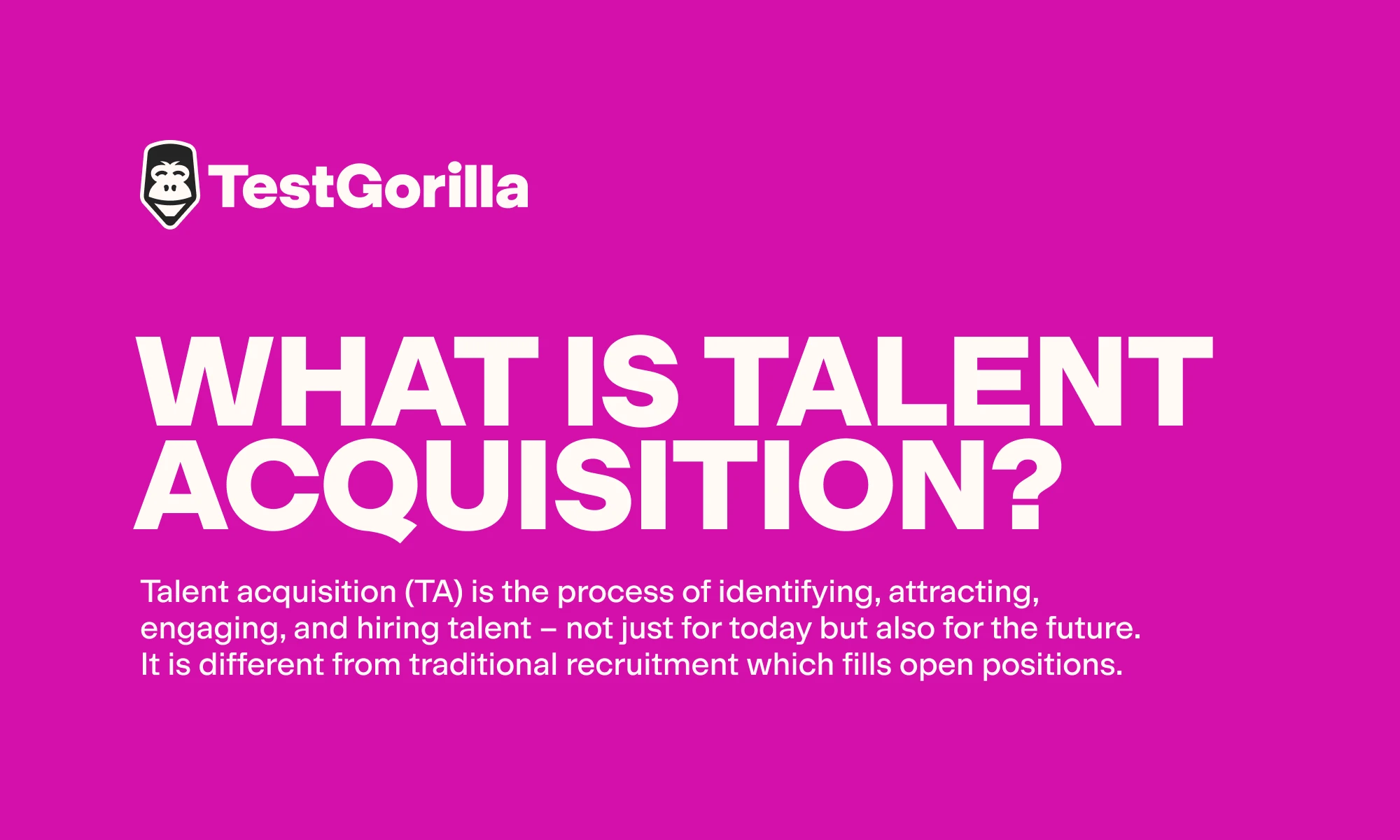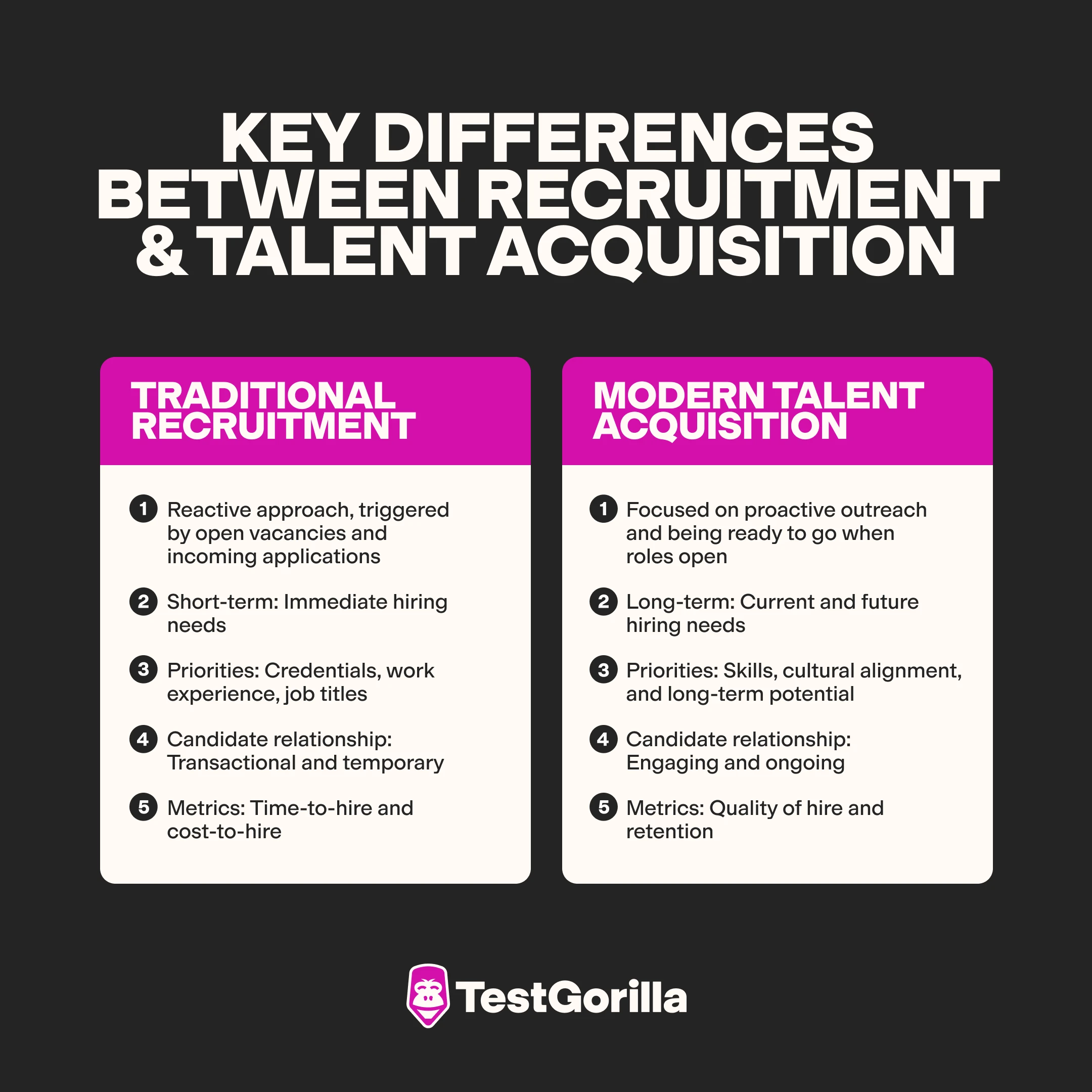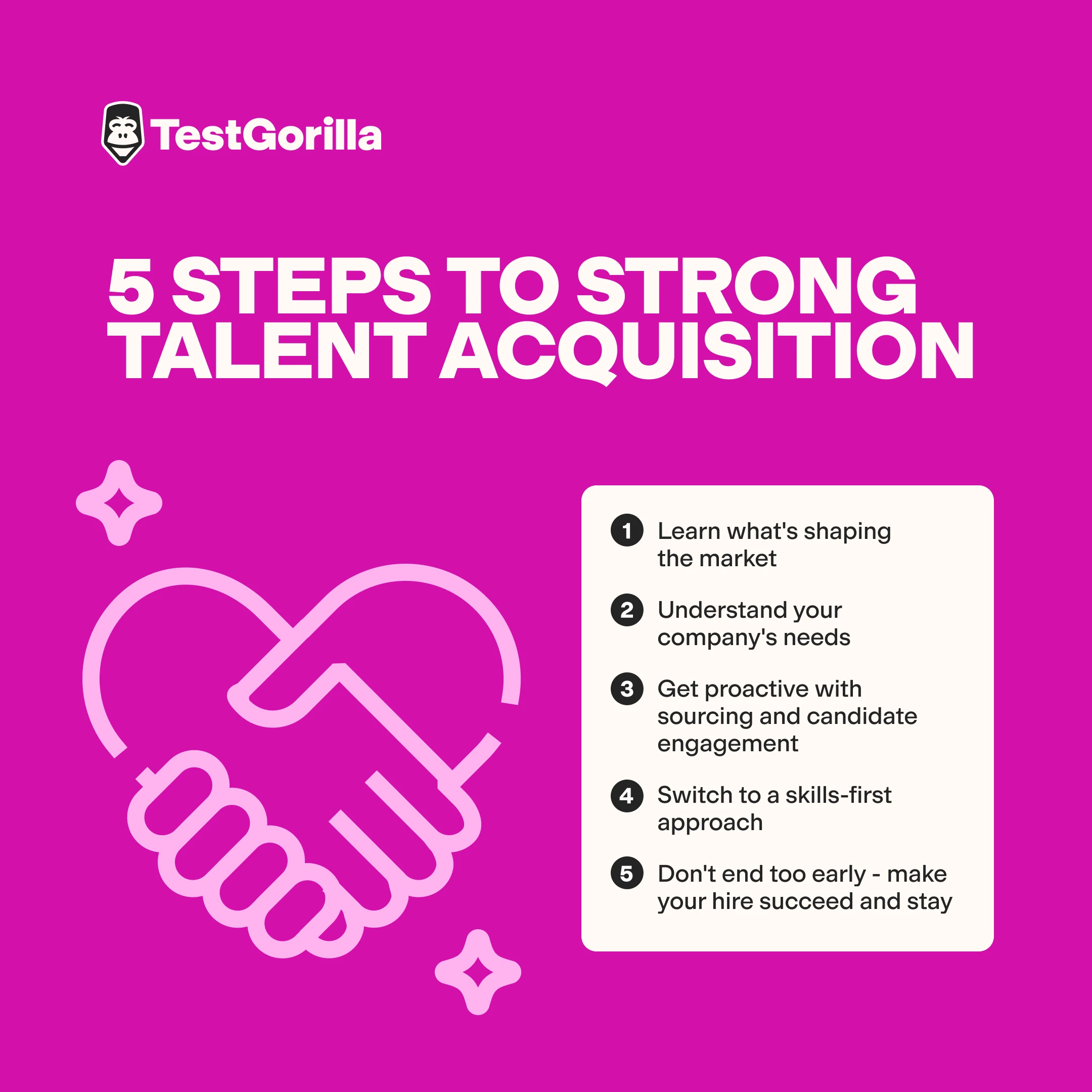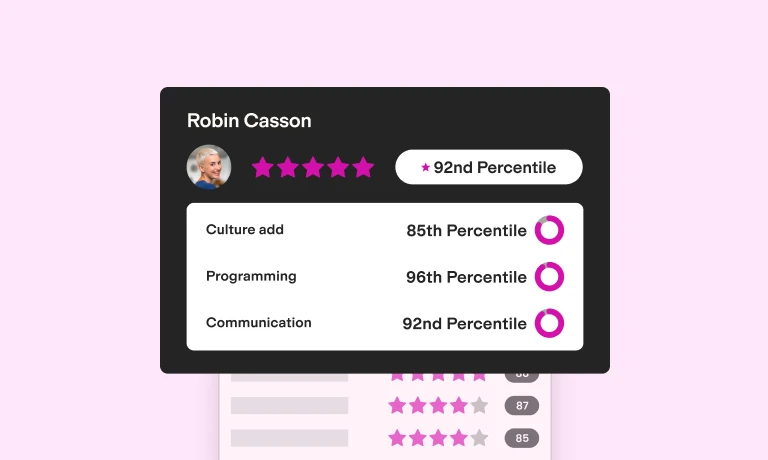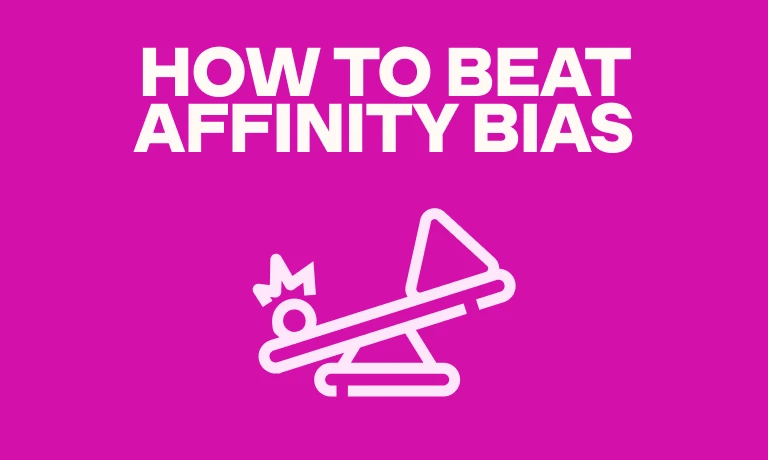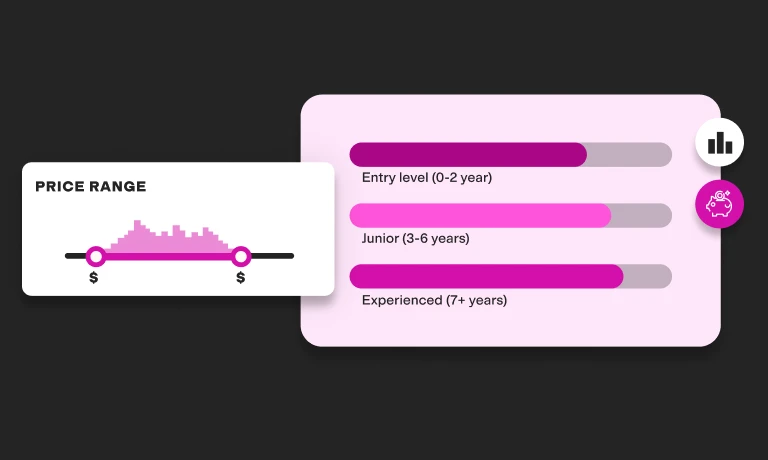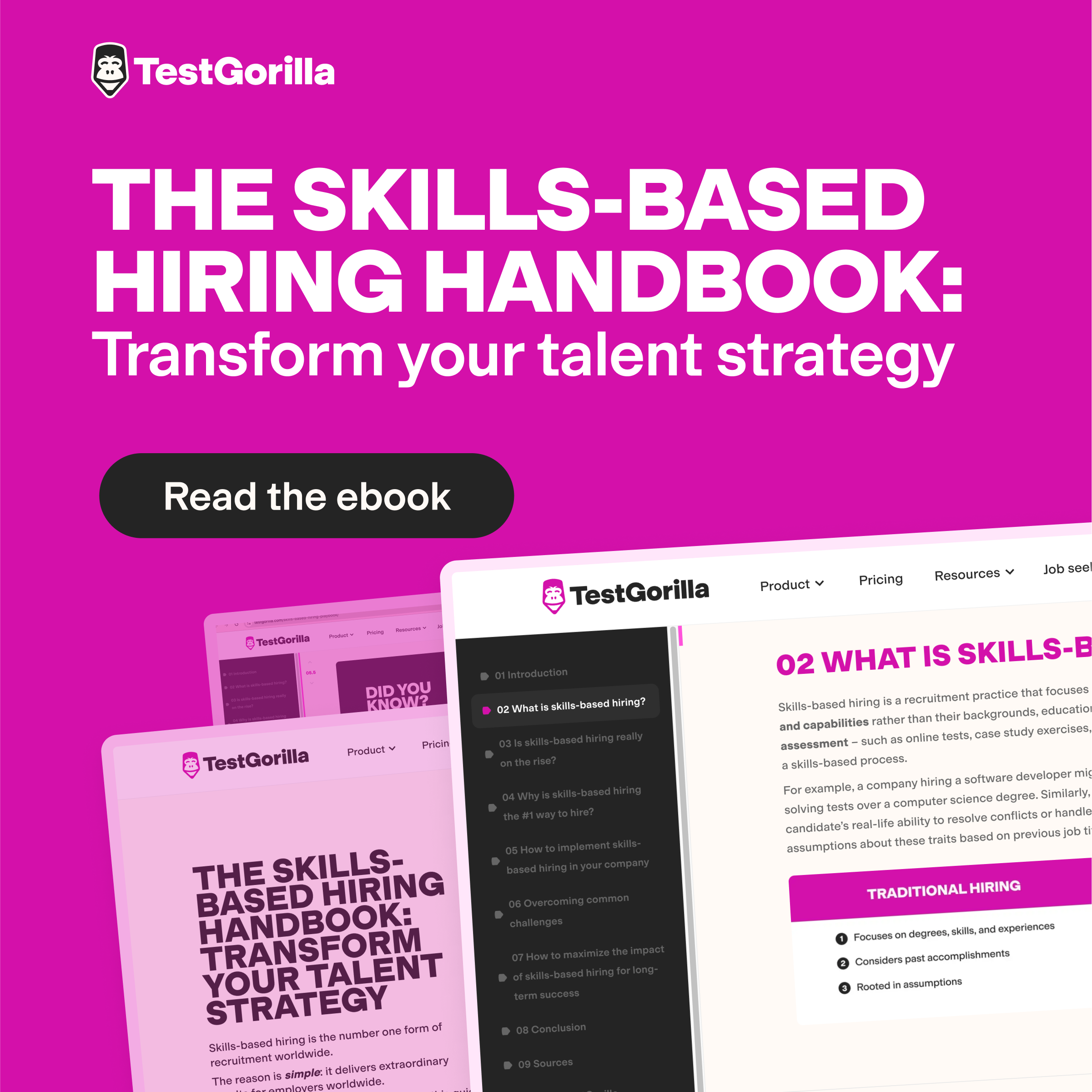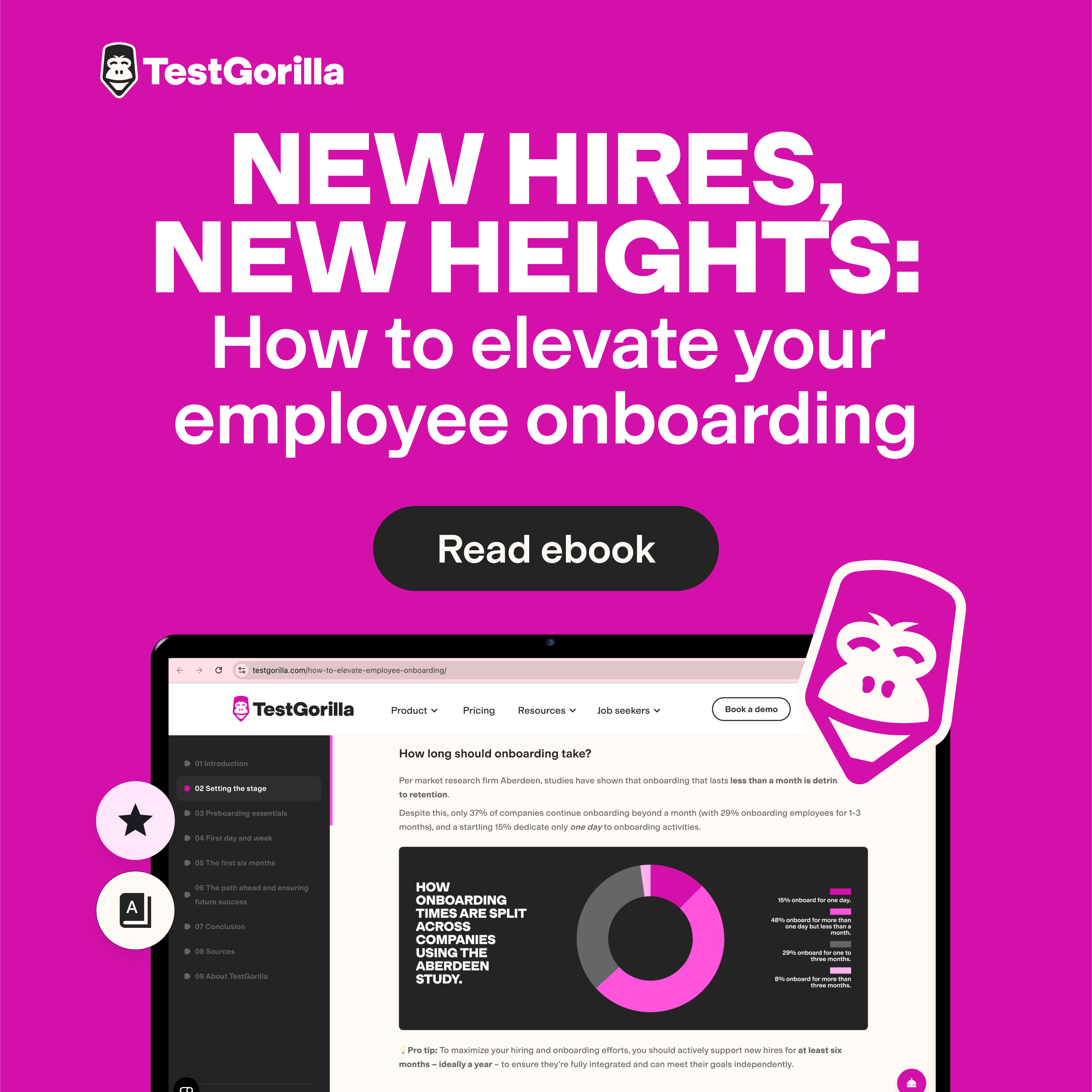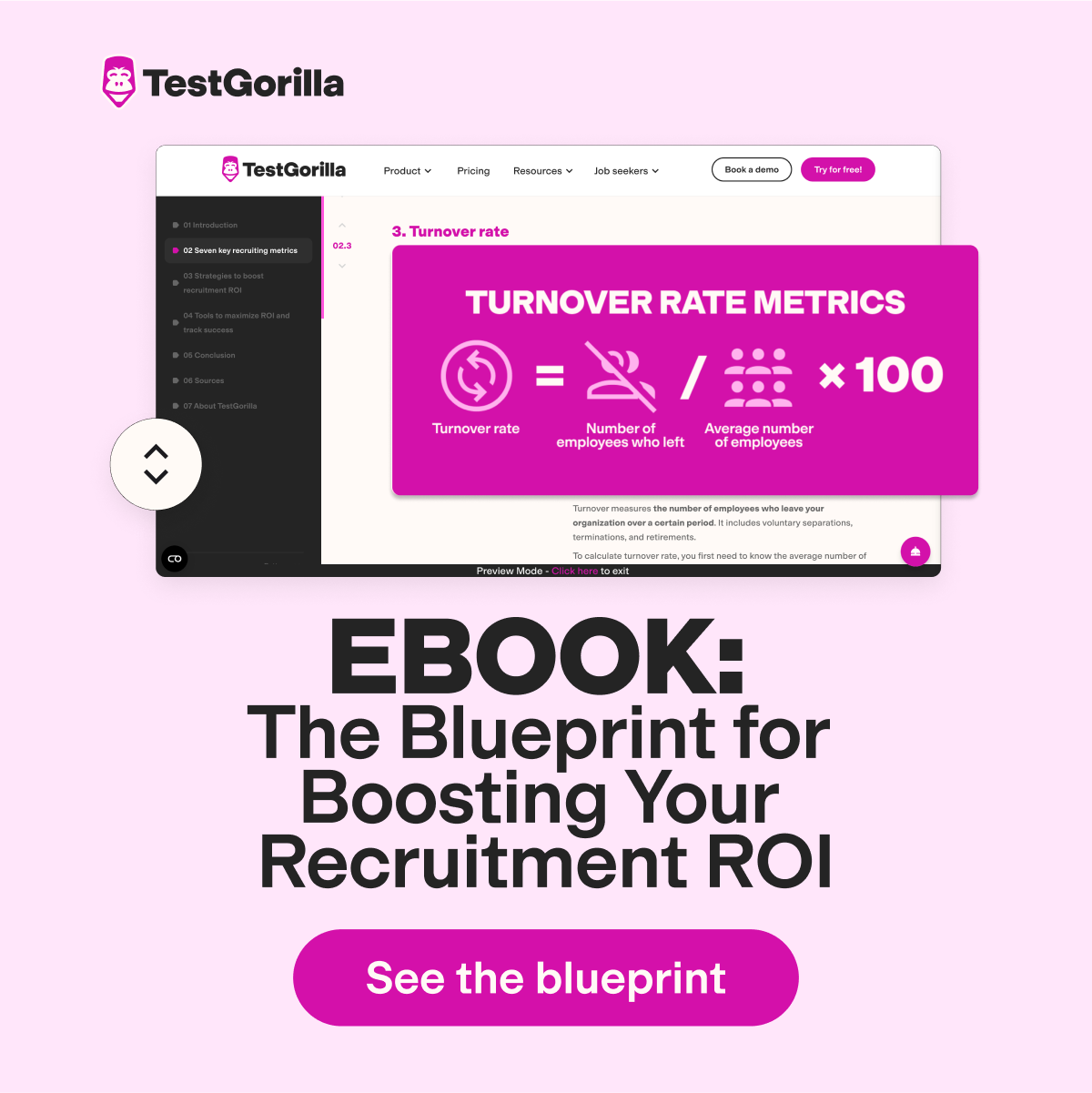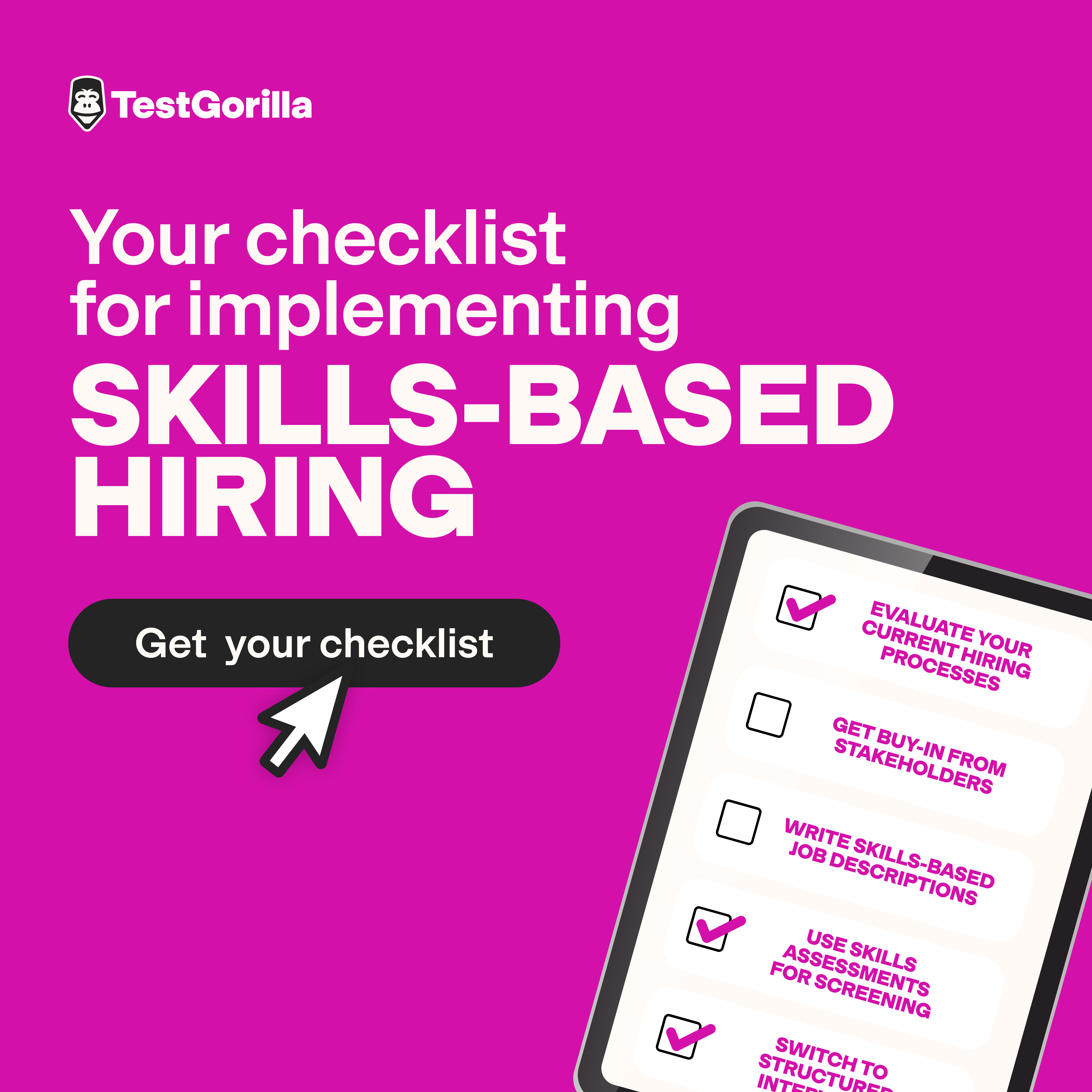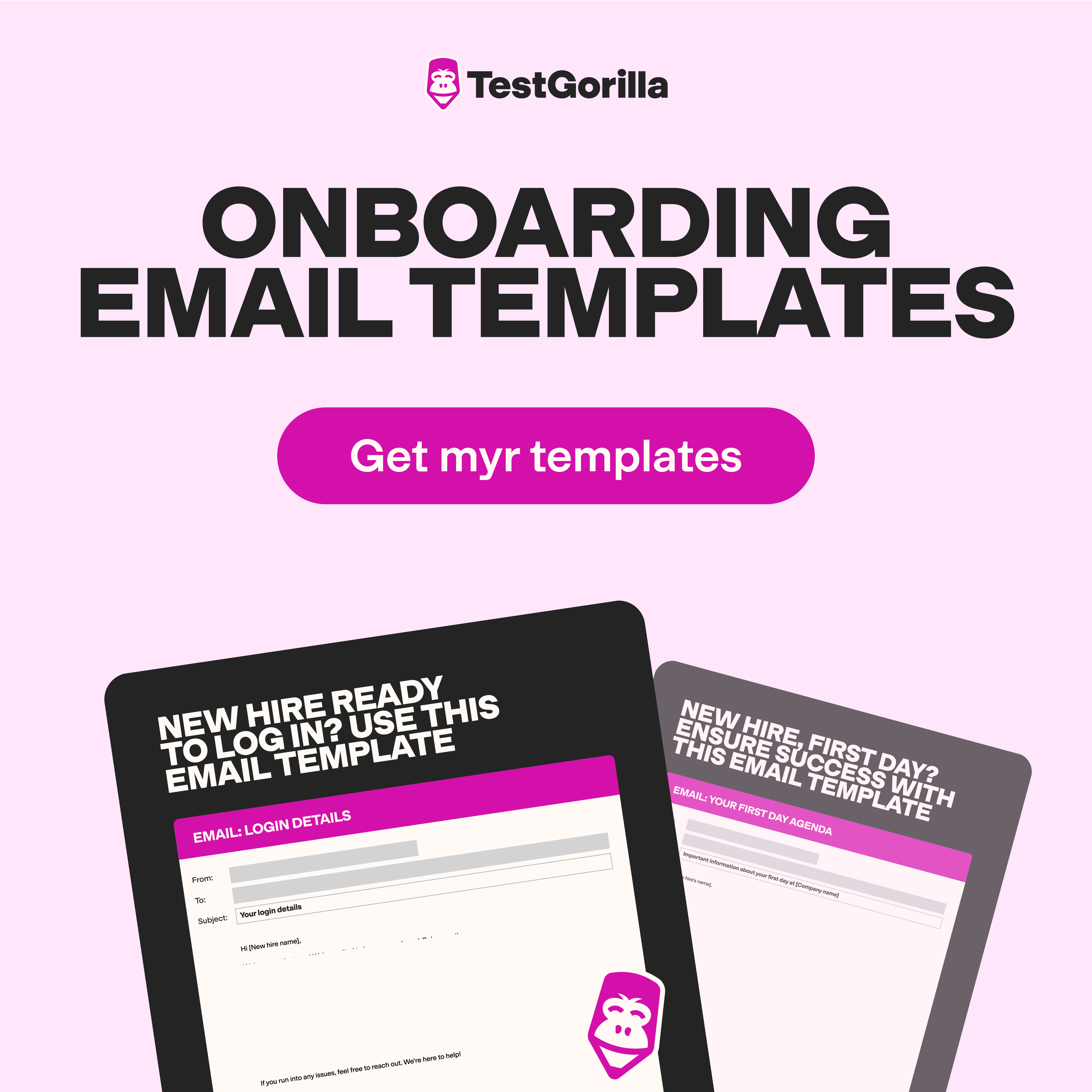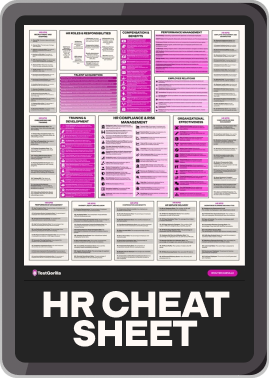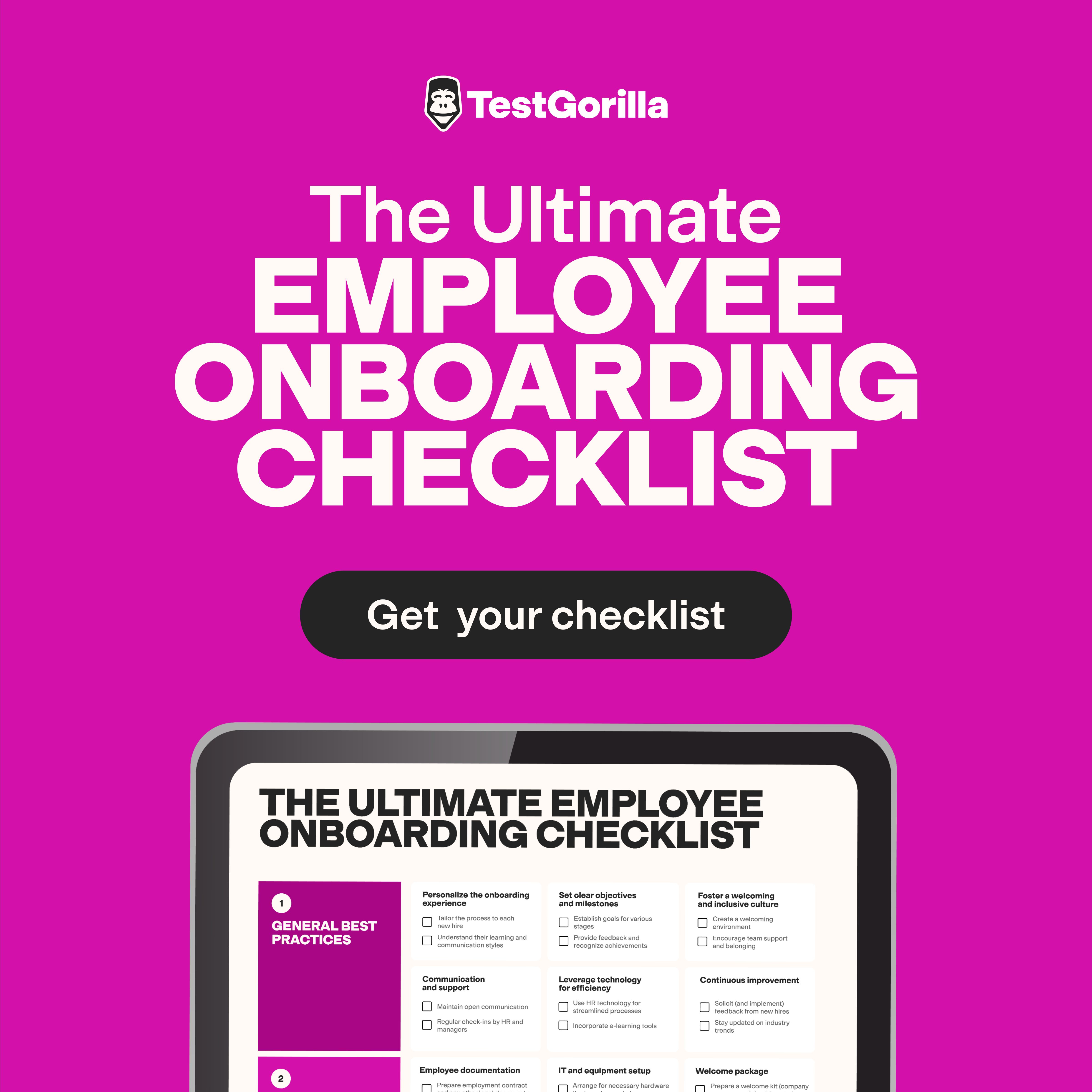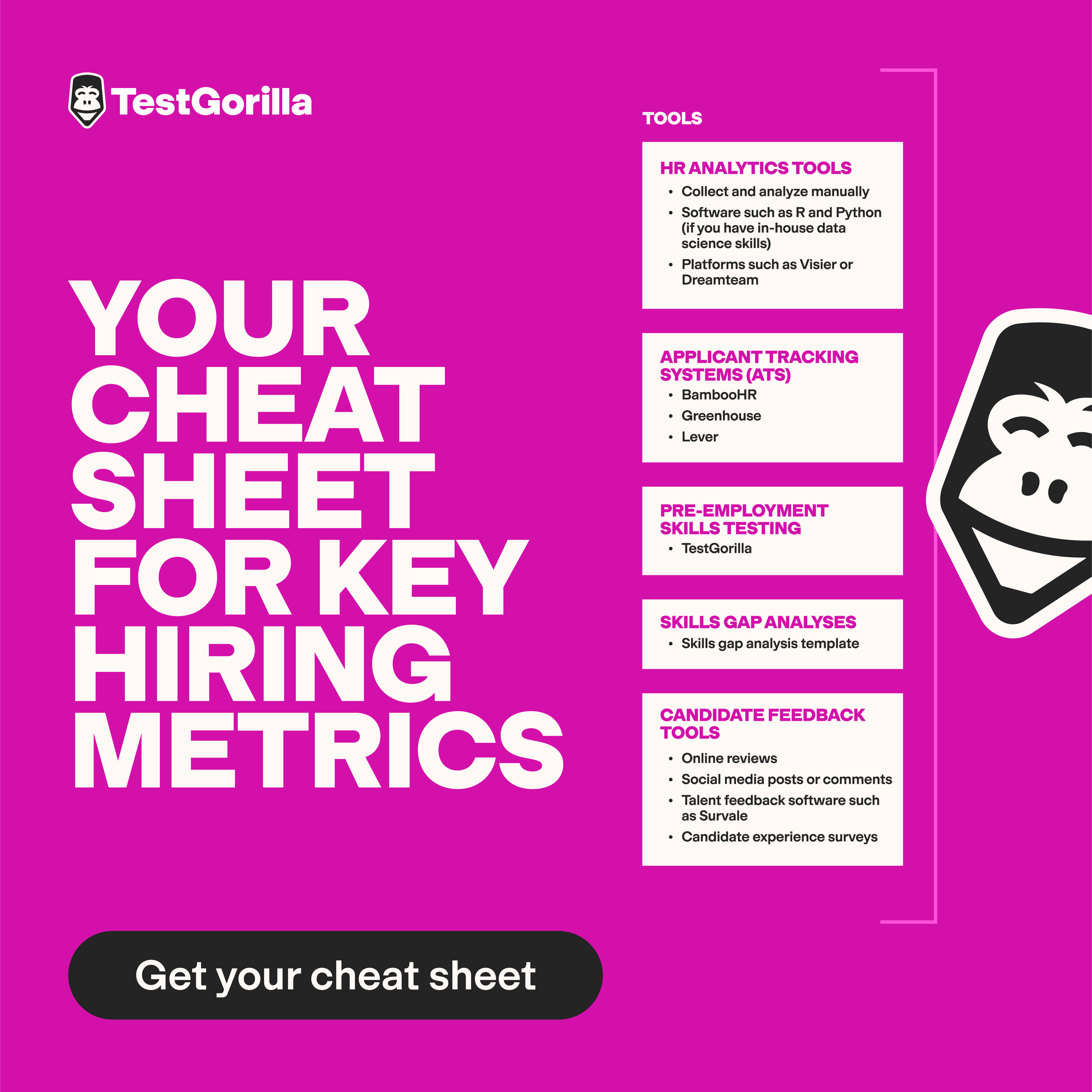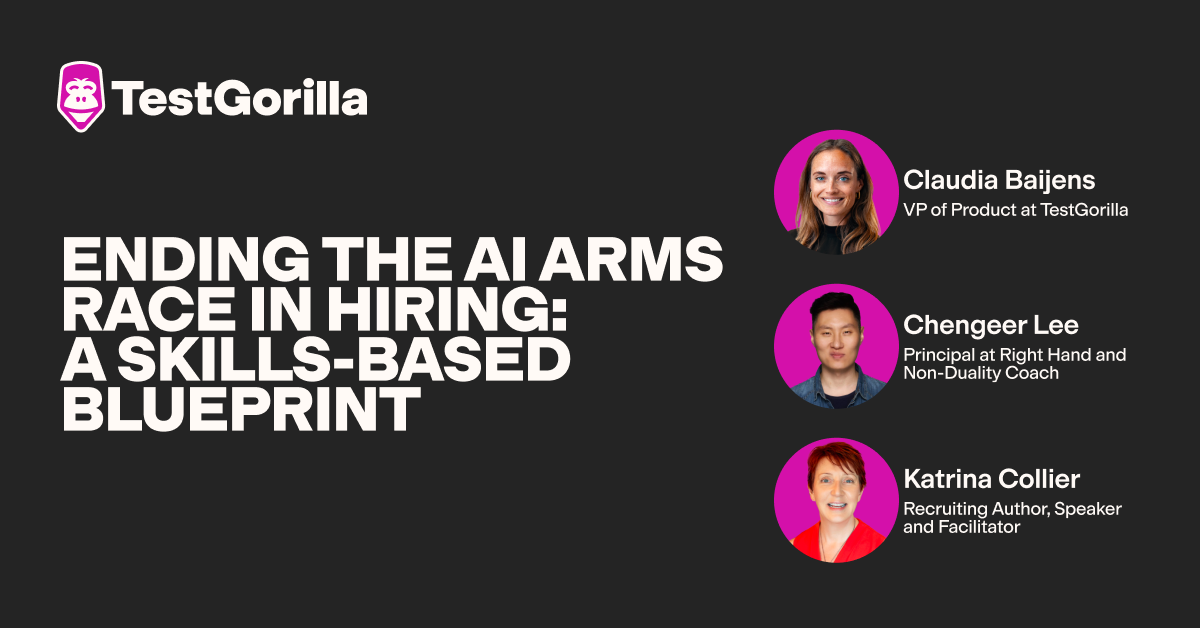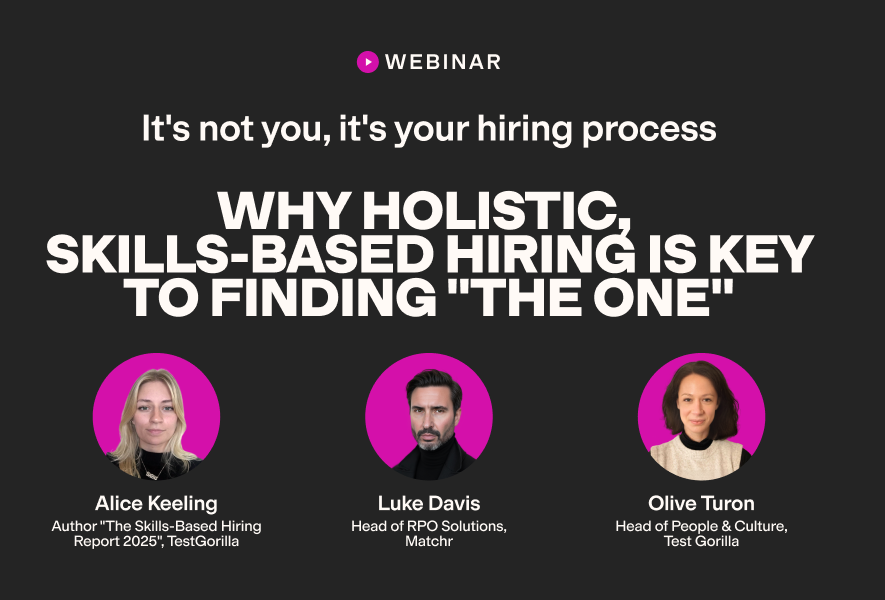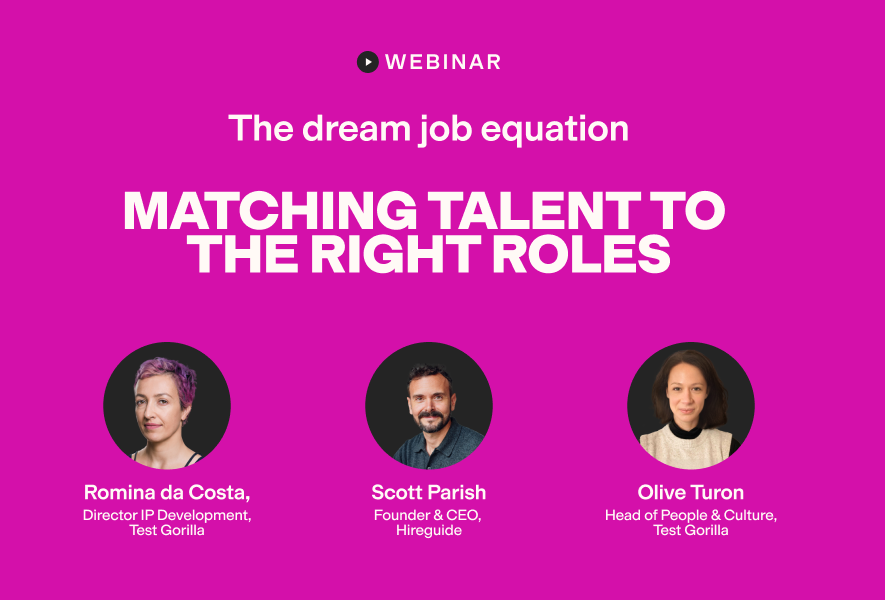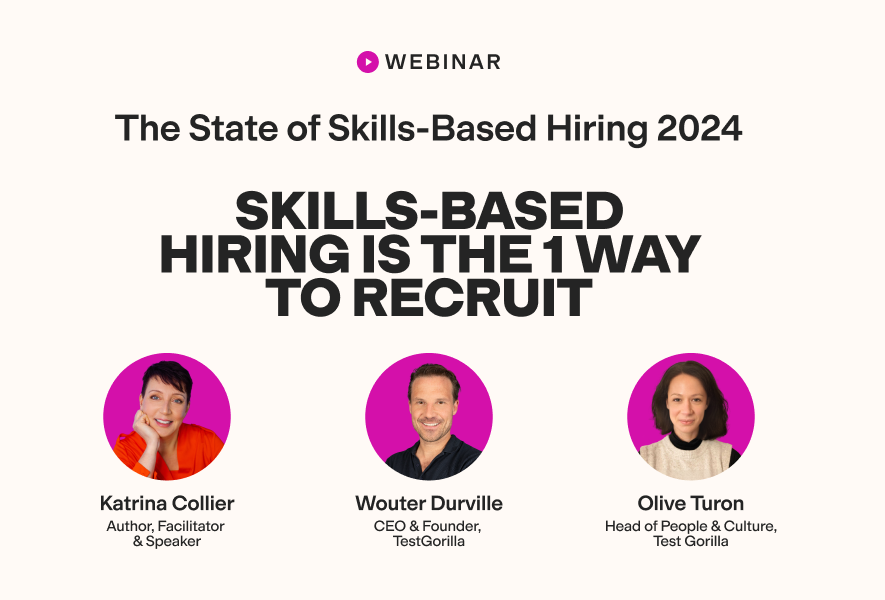TestGorilla’s latest report, "The State of Skills-Based Hiring,” shows that 63% of employers are struggling to find talent. Filling empty seats is one challenge, but putting the wrong people in the wrong seats creates even bigger problems. The world of recruitment is rife with stories of mis-hiring, fire-fighting, employee backlash, and frustrated employers.
On the surface, these look like separate issues. But they all boil down to the same thing – traditional recruiting hasn’t evolved enough to put people into roles that best suit them.
What you need today is a well-thought-out, deliberate, and strategic approach to talent acquisition. One that matches you with the right talent – on everything from skills to values. Here's what strong talent acquisition should look like today and how to get it right.
Table of contents
- What is talent acquisition?
- Your 5-step roadmap for strong talent acquisition
- No budget to grow the TA team? With the right tools, you don't need to
- 3 common talent acquisition challenges and tips to overcome them
- Traditional hiring is out. Strategic talent acquisition is in. The sooner you accept it, the better
- Contributors
What is talent acquisition?
Talent acquisition (TA) is the process of identifying, attracting, engaging, and hiring talent – not just for today but also for the future.
It looks at:
Workforce planning: Analyzing the skills and resources needed to achieve company goals.
Talent Sourcing: Building a pipeline of talent well-suited to the company.
Nurturing candidates: Staying in touch with active and passive candidates, keeping the company top-of-mind for job seekers.
Building a strong employer brand: Establishing your company as a desirable place to work and distinguishing it from competitors.
Matching: Deploying the ideal candidate into the right role when it does open up.
Is talent acquisition different from recruitment? Very much so
Traditional recruitment is the act of filling open positions, often quickly and reactively. It starts with writing a job description for a vacancy, continues with standard hiring processes like reading resumes and interviewing candidates, and ends once you’ve slotted someone into the role.
We spoke to Michał Bieńko, Recruiter at Omni Calculator, who was spot on about the differences.
"Traditional recruitment is more of a service provider approach. [Businesses tell you] what they want, and the recruiter handles all of the operations and makes sure that the process is being followed.
Modern Talent Acquisition is an advisory role that enables the business to make the best hiring decisions possible. That means not only taking care of the process and operations, but also understanding the business context and challenging the business when necessary to uncover their blind spots, reduce the bias, and make sure that the organization hires the truly best candidate for real business needs."
Here's a quick side-by-side comparison to put all of this into perspective.
Aspect | Traditional recruitment | Modern talent acquisition |
Approach | Reactive approach – triggered by open vacancies and incoming applications. | Focused on proactive outreach and being ready to go when roles open. |
Timeframe | Short-term: Looks at immediate hiring needs. | Long-term: Looks at current and future hiring needs. |
Priorities | Credentials, work experience, job titles. | Skills, cultural alignment, and long-term potential. |
Candidate relationship | Transactional and temporary. | Engaging and ongoing. |
Measure of success | Time-to-hire and cost-to-hire. | Quality of hire and retention. |
#TimesUp for old-school recruitment
Why make the switch from traditional recruitment to talent acquisition?
It’s not helping you with today’s talent crunch
According to a large-scale survey of more than 40,000 employers from 42 countries, nearly a third of employers are currently struggling to find skilled labor.
Traditional recruitment relies heavily on incoming applications and resumes, further limiting you to those who actively apply. This means you’ve left out a vast pool of passive candidates who could have been a better fit – far from ideal when the job market is already tough.
It misses the mark even with active candidates
We’ve already seen that employers are finding it hard to secure talent. But our survey found that 70% of job seekers are also struggling to find jobs. This is because traditional recruiting is one-dimensional and resume-obsessed, often relying too much on candidates’ credentials and job titles. The result? You filter out perfectly skilled active candidates and leave your roles empty or filled with the wrong fit.
It hampers diversity and inclusion in your company
HR and hiring expert Yashna Wahal explains this one.
"Let’s call a spade a spade. When you only open your doors to those who can afford a college education or have the right connections to secure top-dog jobs, you’re prioritizing 'certain' backgrounds, ethnicities, and socio-economic statuses over others."
In addition to losing out on skilled talent, any perception of biased or discriminatory hiring practices can also hurt your diversity goals and damage your employer brand.
It forces you into rushed and biased decisions
Since traditional recruitment starts when a role opens, employers often scramble to fill roles quickly before competitors in the ongoing war for talent.
According to Nobel prize-winning Psychologist Daniel Kahneman, humans rely on biases and shortcuts to make quick decisions. So you might end up picking a candidate who made the best first impression instead of taking the time to evaluate candidates for job fit.
What’s more, recruiters are judged based on metrics like time-to-hire, leading to rash decisions and higher chances of getting it wrong.
It actually costs you more (not what you want when budgets are tight)
When you haven’t built an employer brand or spent time engaging candidates, you’re much more likely to turn to pay as a way to attract candidates. But according to Payscale’s 10th Annual Salary Budget Survey, companies have earmarked lower salary increases for the upcoming year. With today’s tighter budgets, throwing money at candidates isn’t sustainable.
Your 5-step roadmap for strong talent acquisition
Here's how to get from point A (your run-of-the-mill recruiting process) to point B (a solid talent acquisition function).
1. Learn what's shaping the market (leave the bubble)
Traditional recruiting tends to follow a fixed script: post a job —> screen resumes —> conduct interviews —> and hire. But over the last few years, external forces have led to some big movements in the job market. Good talent acquisition teams take these into account to build a process that’s relevant and effective.
Here are the key market forces to understand right now.
Jobs are changing
According to the World Economic Forum’s Future of Jobs Report 2025, nearly 40% of the skills required across jobs are expected to change by 2030 as we see tech and AI altering how we work. As such, transferable soft skills and traits like creativity, resilience, curiosity, willingness to learn, and adaptability are topping employers’ priority lists.
Skills are taking center stage
Since many roles won’t look the same a few years down the line, there’s no point looking for rigid degrees and credentials that may become obsolete.
Our research shows that more than half of employers have ditched degree requirements, and 85% are now using a skills-based hiring approach – and candidates want it, too. Our report, "The State of Skills-Based Hiring 2024,” showed that 80% of US and Latin American employees, and 82% of those aged 25-34, preferred a skills-based hiring process.
Candidate sentiments have shifted
Glassdoor’s multi-country survey found nearly three in four job seekers wouldn’t even apply to companies that didn’t align with their values. Additionally, factors like a company’s leadership, career opportunities, and work-life balance matter even more than pay today.
So even employers with deep pockets can struggle to get top talent if they haven’t shown them what they’re about.
DEI is top of mind for employers and job seekers alike
The call for Diversity, Equity, and Inclusion (DEI) is louder than ever. We found that 79% of employers think having diverse teams is important, and 84% said building inclusive teams is critical for their company.
Additionally, a Gartner study showed that negative perceptions of pay equity lead to a 15% decrease in employees’ intent to stay and 13% increase in job-switching behaviors.
AI has arrived
A staggering 65% of employers from around the world and 70% of US employers report using AI in their hiring practices. Here's how they're using it:
60% use it to write job descriptions
59% use it to screen resumes
51% use it to source candidates
20% use it for interviews
These numbers show that AI isn't just a passing trend in talent acquisition. It's touching several parts of the process already and is expected to remain core to finding and evaluating talent.
2. But don't forget your company's needs (look inward)
While external forces have their place, the best talent acquisition experts understand the company’s goals and tailor their hiring processes to align with them. Without this crucial step, you risk building a pipeline of candidates who look great on paper but do nothing to move the business forward.
We asked the experts how they go about this. This is what Michał Bieńko has to say:
"You NEED to start with the business strategy. What kind of team does the business need to get there? What people and competencies [are] your organization currently missing? Which ones do you want to grow in-house?"
If you have a seat at the leadership table, chances are you’re probably clued into this stuff already. If not, talk to leaders and managers to learn what they’re looking for. Audit upcoming projects and any major initiatives planned for the future, and find out what kind of people, skills, or attributes they’ll need.
Wynter Johnson, Founder and CEO at Caily, also provides a clever tactic for this kind of workforce planning.
"Rather than focusing on finding the right candidate for a defined role, [break] that role down into discrete tasks and [make] sure you have the talent to handle them, whether that's through traditional hiring, reorganization, outsourcing, or automation."
Once you’ve answered these questions, you’ll know exactly what skills to hire for. Additionally, don’t forget to work with your internal finance team to understand any budget constraints you’d need to consider in your talent acquisition processes.
3. Get proactive with sourcing and candidate engagement (nobody said it was easy)
Michael Carter, President of Abstrakt Talent Solutions, talks about one of the key aspects of talent acquisition.
"Talent acquisition focuses on proactive outreach in addition to job posting to build a candidate pipeline with qualified individuals – this helps the recruiter regain control of their results by injecting seasoned candidates into the process."
Instead of sitting around and waiting for candidates, tap into your networks and communities – for instance, industry associations, company alumni groups, or local chambers of commerce. You can also build an employee referral program, re-engage past candidates, and find potential matches on social media sites, like LinkedIn or even Facebook and Instagram, depending on the nature of the job.
Once you’ve built a solid base of candidates, ensure you nurture both active talent (those in the hiring process) and passive ones (those you want to keep warm for later). Done well, this helps candidates learn more about your company’s values, culture, working practices, and successes.
This empowers them to "self-select" when applying for jobs, reducing the chances of you needing to screen total mismatches.
Here are a few ways to engage your candidates:
Stay in touch with the occasional email or call. You can share industry insights, company news, and even tailored content to stay on their radar and make them feel valued.
Communicate company wins. Faraz Hemani, Owner and CEO of Iron Storage, says he communicates actual wins such as store openings, new markets, and acquisitions to "make [candidates] envision themselves as a part of what [we're] building."
Showcase your company’s community initiatives, values, or team testimonials to help candidates understand why you’re a good place to work.
4. Switch to a skills-first approach (stop obsessing over vanity criteria)
Perhaps the single biggest shift in modern talent acquisition has been the move from degree-based hiring to skills-based hiring. A great starting point is to de-list unnecessary degree and job title requirements from your job descriptions and instead write ones that focus on the skills needed for the role.
Additionally, traditional recruiting has had a heavy focus on resumes, which list candidates’ credentials, fancy job titles, and years of experience – none of which can guarantee that a candidate is truly a good fit for a job. And let's not forget that about 70% of candidates admit to lying on their resumes, making it even harder to separate fact from fiction.
We recommend moving away from resumes and making decisions based on candidates’ real-world skills. Additionally, instead of just taking their word for it, put candidates through tests, case studies, and practical tasks that actually verify these skills and capabilities.
How does this help?
It opens the doors to so many more candidates – especially those who don’t have a formal degree but have gained skills through alternative routes.
It boosts diversity efforts by attracting a wider range of candidates, both active and passive.
It reduces the biases that you often see in the resume screening process – for example, picking candidates from one’s alma mater or someone with similar hobbies instead of looking for abilities.
It helps you vet everyone in your pool so you’re not wasting your time and recruiting budget on poor fits.
What’s the best way to vet skills?
Talent assessments are the most popular way to measure job seekers’ skills. Platforms like TestGorilla, for instance, let you evaluate candidates on everything from technical skills to soft skills, cognitive abilities, personality traits, and even cultural alignment.
This makes it possible to build pools of candidates who truly match your company. It’s precise, targeted, and almost foolproof.
Importantly, we’re not the only ones who think so. Tracy Thornton, Chief People Officer at the DDC Group and CIPD fellow, explains:
"Utilizing tools such as skills assessments or job/task simulations provides a more objective approach to enable good hiring decisions, moving away from a reliance on a gut feeling or the unconscious bias we know can still happen on resume review alone."
And, the data backs it up. We recently found that 76% of employers are using skills tests in their hiring process, and a majority of them believe these tests are better predictors of job success than resumes. With stats like that, skills testing isn’t a fad. It has become core to strong talent acquisition, and it’s here to stay.
5. Don't press the end button too early (TA doesn't end at an offer)
Unlike traditional hiring, talent acquisition doesn’t stop when someone signs an offer. The TA team gets involved with employee onboarding and contributes to making that hire succeed – and stay.
Why is this important?
A Harvard Business Review report showed that 20% of staff turnover is attributed to new hires leaving within the first 45 days.
Meanwhile, a recent study showed that effective onboarding helped employees with socialization and reduced turnover, especially when it was personalized to their learning styles and roles. Having spent time building and nurturing relationships, talent acquisition teams are in a great position to help with this.
Here’s how you can work with new employees and their managers to ensure a smooth transition:
Design a structured onboarding process tailored to the employee’s role and preferences.
Set expectations clearly so new hires understand their responsibilities, goals, and how they’ll be evaluated from day one.
Stay in touch regularly during the early weeks and months, and support new hires with any questions or concerns.
Monitor early turnover through exit interviews and use the insights to address any recurring issues.
The best insights on HR and recruitment, delivered to your inbox.
Biweekly updates. No spam. Unsubscribe any time.
No budget to grow the TA team? With the right tools, you don't need to
We get it: implementing a proper talent acquisition strategy can feel daunting. You’ve added elements like workforce planning, sourcing, skills testing, vetting, and onboarding to an already admin-heavy recruitment process.
And let’s face it – you’ll still need to manage candidate comms, schedule interviews, draft offers, and more. In today’s cost-cutting environment, asking for a bigger team to cope with this workload is often off the table.
With that in mind, we asked Michael Carter how employers are managing the shift from traditional recruitment to talent acquisition. He makes a crucial point:
"Companies are implementing AI solutions to eliminate time-consuming busy work with a goal to drive more revenue with the same headcount. Talent acquisition companies that do not adopt these tools will be outperformed by forward-thinking competitors."
Talent acquisition has made some incredible strides in leveraging tech and AI to scale impact without scaling headcount. Here are the top tools to add to your arsenal.
Tool | Benefits |
Workforce planning software | Often found in software like Workday or Oracle, these tools help you map out your employees' current skills or competencies and compare them to your company's needs. |
AI resume screening | Cuts hours of manual resume reviewing by scanning and shortlisting resumes based on relevant keywords. Some platforms, like TestGorilla's upcoming AI resume scoring tool, can read every resume and auto-score candidates based on skills, and produce a list of best-fit matches. |
Generative AI for writing job descriptions | Tools like ChatGPT help with writing job descriptions from scratch or editing your existing job descriptions – for instance, scanning them for gendered or biased language, spelling mistakes, clarity issues, and more. Some recruitment software also has these tools built in. |
Skills assessment platforms | Offer ready online talent assessments and auto-score and rank candidates based on their results. TestGorilla, for instance, has 350+ tests, covering hard and soft skills, cognitive abilities, personality traits, cultural alignment, and more. This objective data helps reduce the likelihood of biased screening and sourcing decisions.
Additionally, TestGorilla's AI can recommend your ideal set of assessments from your job description or even just a job title. |
Sourcing tools and platforms | Gives you access to large pools of passive candidates. Some platforms, like TestGorilla Sourcing, connect you to more than 2 million skills-tested candidates, with more than 100,000 new profiles added every month. You can set filters like skills, location, and more, and the AI instantly provides qualified and vetted matches. This is excellent for sourcing at scale. |
Applicant tracking systems (ATS) | Lets you create jobs, post them via job board integrations, and gather and track incoming job applications. Some ATS platforms like Greenhouse and Lever also provide built-in scheduling and candidate communication tools to help you cut down admin tasks. |
CRM (candidate relationship management) tools | Specialized software like Zoho keeps passive candidates engaged through automated campaigns, personalized updates, newsletters, and other content. You can even view communication histories and make notes about candidates to tailor your approach when you reach out. |
AI video interviews | Replaces time-consuming screening calls with one-way video interviews or conversational AI interviews. TestGorilla's AI video interviews ask customized questions (including follow-up questions), auto-score responses against your criteria, and evaluate candidates consistently, reducing both manual work and the biases often seen in human interviewing. |
Analytics tools | Provide valuable data and insights across your hiring funnel. For instance, TestGorilla Analytics tracks invite-to-completion rates, drop-off points, score distributions, and recruiter usage for skills assessments.
Similarly, some ATS platforms track conversion rates between different stages of hiring, while CRMs can tell you if candidates open your communications, click links, and more. |
3 common talent acquisition challenges and tips to overcome them
These are some of the most common challenges that even skilled talent acquisition experts face.
Tech and AI doing you dirty?
While tech and AI tools can take a lot of the load off, they’re far from perfect. For example, Amazon famously scrapped its AI recruiting tool after it was found to perpetuate biases against women’s resumes.
Even widely used tools like LinkedIn’s Boolean search have frustrated recruiters by returning poor-quality candidate matches and prioritizing profiles with higher platform activity, which has nothing to do with someone’s readiness for a job.
In fact, such problems have led to a number of AI-related lawsuits. For instance, in the Mobley vs. Workday case, it was alleged that Workday's AI screening tools discriminated against older candidates.
To mitigate these risks, audit your tools regularly and avoid any that seem biased or flawed. Additionally, Michał Bieńko warns against overrelying on AI at the cost of setting up a skilled talent acquisition team.
"Companies with mature TA [functions], well-structured hiring processes, and well-trained hiring managers are ready to take their hiring operations to the next step, and AI will be the key enabler. Meanwhile, companies that didn’t take care of the proper TA foundations might use AI to [optimize] working on unnecessary or even unintentionally harmful things. AI will broaden the hiring quality gap."
Can't let go of resumes?
86% of US employers told us they struggle with assessing candidates’ actual skills, ranking them fairly, and verifying resume accuracy – not to mention the sheer amount of time it takes to read them. While resume reliance has dropped by 8% over the last year, 67% of employers still use them. And we get it – old habits die hard.
If you can’t ditch resumes entirely, changing where you use them can make a difference. We found that those who use talent assessments to validate skills before looking at resumes report better-quality hires (96%) than those who screen resumes first (87%).
Not getting a seat at the table?
Some business leaders still view talent acquisition as a purely administrative function rather than a strategic partner. This makes it harder to secure budgets, earn leadership confidence, and influence a company’s direction.
One way to get leadership buy-in is to speak their language. Stop showing them shallow metrics like time-to-fill alone, and focus on measures of talent acquisition success that resonate with business priorities. For example:
Quality of hire: Measure performance ratings, promotions, and manager feedback.
Retention: Highlight first-year retention metrics and their impact on your company’s overall turnover.
Time-to-productivity: Track how quickly new hires start contributing to business goals.
Diversity data: Shows that you’re attracting better talent and boosting the company’s external reputation.
Finally, Michał Bieńko explains that when you truly do need more resources for talent acquisition, lay your case with data and speak up.
"Know your historic turnover and your hiring velocity. This will show you if you need to grow your TA team, invest in TA tools, or have some tough talks with C-level, that they need to be more realistic about their hiring goals."
Traditional hiring is out. Strategic talent acquisition is in. The sooner you accept it, the better
Talent acquisition is several notches above standard recruitment. It’s a forward-looking, strategic function that keeps pace with today’s fast-changing landscape. It improves the quality of your hires, reduces turnover, and helps you build a strong employer brand.
You can build a solid talent acquisition function by aligning with company goals, building a pipeline of talent and nurturing them, adopting skills-first assessments, and extending your focus beyond the offer to onboarding and retention.
While this sounds like a lot, the right tech and AI tools can make all the difference. For instance, TestGorilla can help with a wide range of TA needs, from talent sourcing to skills assessments, interviewing, and analytics – significantly easing your load while giving you valuable insights to continue refining your talent acquisition practice over time.
Sign up for a demo or create a free account with TestGorilla today.
Contributors
Faraz Hemani, Iron Storage, Owner & CEO
Michael Carter, Abstrakt Talent Solutions, President
Michał Bieńko, Omni Calculator, Recruiter
Tracy Thornton, DDC Group, Chief People Officer
Wynter Johnson, Caily, Founder and CEO
Yashna Wahal, HR and hiring expert
You've scrolled this far
Why not try TestGorilla for free, and see what happens when you put skills first.


